
|
|
|
|
|
|
|
|
|
|

|
|
|
|
|
|
|
|
|
|
|
|
|
|
|
|
|
||||||
|
|
|
||||||||

|
Vinyl wraps have become increasingly popular in recent years, especially in the automotive and design industries. They offer a cost-effective and versatile way to change the appearance of vehicles, furniture, or even walls. Among the many colors available, red vinyl wraps are particularly striking and frequently chosen for their bold and vibrant appeal. However, as environmental concerns grow, many people are questioning the eco-friendliness of vinyl wraps, including the red variety. To determine whether red vinyl wraps are environmentally friendly, it's essential to understand what they are made of. Vinyl wraps are typically made from polyvinyl chloride (PVC), a type of plastic that is durable and flexible. Unfortunately, PVC is derived from non-renewable fossil fuels, and its production involves the release of harmful chemicals, including chlorine and dioxins. These substances can pose risks to both human health and the environment during the manufacturing process.Car Wraps In addition to production concerns, disposal is another significant issue. Vinyl wraps are not biodegradable, meaning they do not naturally break down in the environment. When discarded, they can contribute to plastic waste in landfills or even end up as microplastics in oceans and ecosystems. Recycling vinyl wraps is also challenging due to their composition and the adhesives used to apply them. However, there are some ways to mitigate the environmental impact of red vinyl wraps. For instance, many companies now offer high-quality wraps designed to last for several years, reducing the frequency of replacement and waste generation. Additionally, some manufacturers are exploring more sustainable materials and production methods, such as using non-toxic inks for coloring and reducing energy consumption during manufacturing. If you're considering using red vinyl wraps, there are steps you can take to make a more environmentally conscious choice. Look for wraps from companies that prioritize sustainability and transparency in their production processes. Choose products with certifications or labels that indicate eco-friendly practices. Furthermore, when it's time to remove the wrap, consider working with recycling programs or specialized facilities that can handle vinyl materials responsibly. In conclusion, while Red Vinyl Wraps are visually appealing and practical for many applications, they are not inherently environmentally friendly due to their PVC composition and challenges with disposal. However, by opting for durable products and supporting brands that prioritize sustainability, you can reduce their environmental impact. As technology and manufacturing processes evolve, we may see more eco-friendly alternatives emerge in the future. Until then, thoughtful choices and responsible usage remain key to minimizing harm to the planet. |
|
|
|
||||||||